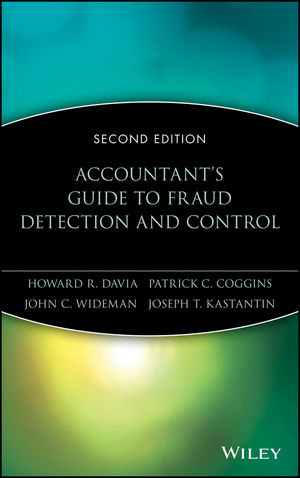Accountant's Guide to Fraud Detection and Control, 2nd EditionISBN: 978-0-471-35378-2
Hardcover
384 pages
March 2000
 This is a Print-on-Demand title. It will be printed specifically to fill your order. Please allow an additional 10-15 days delivery time. The book is not returnable.
|
||||||
From internal control structures that are not fraud-specific toinsufficient communication in the fraud discovery-to-investigationand conviction process, fraudulent activity is a widespread fact oflife in the business world. Historically, the corporate tendencyhas been to react to fraud after the fact, rather than to beproactive in its prevention. And in most cases, blame is directedat accountants and auditors. Unfortunately, these officers arerarely provided with the resources, proper training, and commitmentfrom top management that are essential to effective fraud detectionand control. The Accountant s Guide to Fraud Detection and Controloffers comprehensive direction for this largely unchartedarea.
Two types of fraud are addressed in this book: fraudulent financialreporting, also known as "Treadway" fraud, usually originating inthe top management sector; and "asset-theft" fraud, the more commonand more costly type, likely to be practiced by virtually anyone,including outsiders. Treadway fraud is being adequately detected byindependent auditors (CPAs) in their annual audits. Asset-theftfraud is not being adequately detected by anyone, with very fewexceptions. From following clues to achieving a prosecution, hereis sound advice that accountants and auditors will findinvaluable.
Businesses lose over $100 billion a year to fraud. Only 20 percentis discovered. Who s to blame?
Accountants and internal auditors are often the scapegoats formanagement s insufficient fraud detection operations andguidelines. At last, here is comprehensive, intermediate trainingfor evaluating, devising, and installing fraud-specific internalcontrols, and for conducting proactive fraud-specific examinations.Including actual case studies, the authors show accountants andauditors how to:
* Anticipate problems and follow clues
* Successfully disclose fraud
* Compile the evidence necessary to prosecute acts of fraud
* Develop investigative techniques
* Create effective internal controls . . . and much more, to fillthe needs of this crucial area.
www.wiley.com/account ing
Two types of fraud are addressed in this book: fraudulent financialreporting, also known as "Treadway" fraud, usually originating inthe top management sector; and "asset-theft" fraud, the more commonand more costly type, likely to be practiced by virtually anyone,including outsiders. Treadway fraud is being adequately detected byindependent auditors (CPAs) in their annual audits. Asset-theftfraud is not being adequately detected by anyone, with very fewexceptions. From following clues to achieving a prosecution, hereis sound advice that accountants and auditors will findinvaluable.
Businesses lose over $100 billion a year to fraud. Only 20 percentis discovered. Who s to blame?
Accountants and internal auditors are often the scapegoats formanagement s insufficient fraud detection operations andguidelines. At last, here is comprehensive, intermediate trainingfor evaluating, devising, and installing fraud-specific internalcontrols, and for conducting proactive fraud-specific examinations.Including actual case studies, the authors show accountants andauditors how to:
* Anticipate problems and follow clues
* Successfully disclose fraud
* Compile the evidence necessary to prosecute acts of fraud
* Develop investigative techniques
* Create effective internal controls . . . and much more, to fillthe needs of this crucial area.
www.wiley.com/account ing



